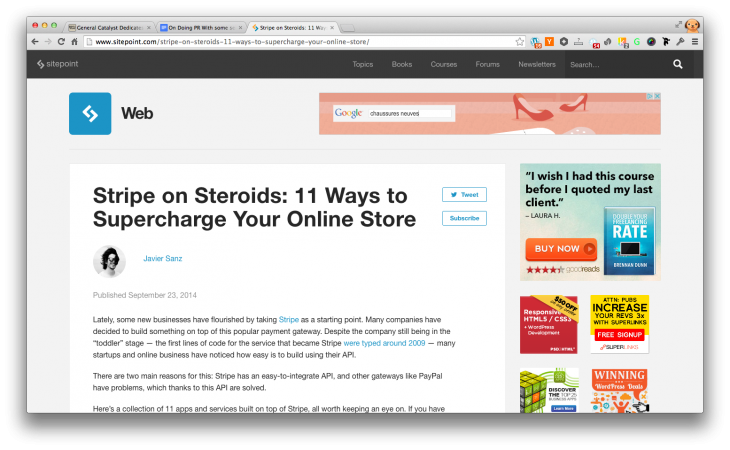
Javier Sanz is a marketer at Quaderno.
The moment has arrived: Startups and companies are pitching media with guest posts that, instead of providing some real value to the reader, are more of a quick, easy, fast, dirty – and usually not good in terms of conversion – way of promotion.
Weeks ago, I remember reading something on the internet to the effect of ‘doing PR and pitching media to cover your thing is just a matter of calling the right API. Don’t pretend to call an API which does not exist, adapt to it.’
Geeky, yes – and right too.
Before going ahead, if you don’t know how an API works (the guys at Zapier have a great introduction for newbies with interactive examples), in very few words: you give a command to a computer to get something from it. Your command will have to be in a certain format so the API understands it, otherwise you won’t get anything.
Now replace ‘API’ with ‘big media site.’ You make an order to get something from it, but if you don’t do it according to the format or give the information they’re looking for, you won’t get anything from that site.
I do marketing for startups, and after many unanswered emails inviting journalist and bloggers to cover what I was working on, I’m telling you that to succeed more, you need to spend some time understanding what the media expects from you.
This is my attempt to show you how we can do a better PR not only for a better profit, but to not treat our audiences disrespectfully. Because that’s what you do when you gate-crash one of your information-less posts just for the sake of promotion.
Stop guessing how to describe your product: This is how to find out
First things first, have a clear idea of what your product is. This is an important step where many fail just by using the description in the H1 tag of their landing page. That’s how you described you. Others might have a different perception of what are you offering.
Some ways I use to disclose exactly what you’re offering in the point of view of others:
1. Google Analytics allows you to see integrated all the queries gathered from Google Webmaster Tools. Follow Google Analytics > SEO > Queries to find what search queries land users on your site.
Figure out how users refer to your product through customer support queries. This is how we found out that instead of ‘invoicing tool,’ some of our users describe our solution as an ‘invoice generator for Stripe.’ And that’s what we’ve used so far.
After 1,700 hours+ doing support for my latest employer, I understood that even if we insisted blindly in selling ‘online reviews,’ our users called them ‘reports.’
2. Use paid tests through Facebook Ads or AdWords, ask them directly (Qualaroo, Typeform) or pick up the phone! Even in 2014, it’s amazing how much return can provide a mere phone call. Believe me.
Few times, a product, a service or whatever you are looking to put out there will have just one kind of audience. Even the simplest thing can have different audiences interested. Going just behind a certain group of potential clients can not only saturate them, but your company.
The first promotion of the latest product I was working on was entirely done to gain the attention of Stripe users. I knew that we had to go behind users who have Stripe integrated as their payment gateway. What we came up with more in detail was:
- Businesses running on Stripe (obviously)
- Developers and Web designers, in case they are looking for a solution like ours for their clients
- E-commerces and SaaS businesses that have a great amount of invoices
- Those that had to comply with European VAT laws. Not as easy as issuing a receipt like in USA. In fact, it’s pain-in-the-ass on this side of the ocean.
Once you know these both answers, it’s when you are ready to do PR with some sense.
Think of PR as something other than pitching
While doing PR and marketing for others, I have learned to find opportunities that go beyond pitching a press releases to media sites. Here are the latest five I did:
1. Research general big media sites and pitch custom content
Find out what type of content they might look for. Is it articles from a personal point of view, or data-proof experiences that can help others or unusual stories from the digital world?
Some examples I recently bookmarked:
- Recode: The myth of Venture Capital
- Wired: This Illustrator Makes $100K Selling Virtual Paintbrushes
➔ What we tried:
I researched the right websites to place this article: “Transparency is the new marketing.”
Companies like Buffer, Baremetrics or Mattermark are great examples of it. Even indie devs are joining the party by posting their own income reports where they detail how much they’ve earned and where that money is coming from.
Since this is a hot topic and can help encourage others to share what they are trying or what worked for them, we offered this article for the sake of better internet culture.
2. Find websites where your audience already hang out
Big media sites are okay for reaching out the public, but you have to go where your potential audience is. Since our product can be implemented by Web devs, I decided to look for sites with great traffic that can help developers.
That’s how I came across sites like SmashingMagazine, Tut+, HongKiat, SitePoint and a great list of online learning sites. You can use tools like Semrush or SimilarWeb to help find the sites you want to target.
So what type of content they might look for? Tutorials, step-by-step guides, articles with the latest new in a certain technology, framework or platform.
Some examples I bookmarked:
➔ What we tried:
I’m not that big a fan of listicles, but they often gain so much ‘virality’ than I cannot ignore their potential. Using this as a starting point and that our tool is created on top of Stripe, I pitched these outlets a listicle about apps built on top that payment gateway.
SitePoint accepted to post it, so we were able to put ourselves in front of at least 500 potential future integrators of our solution (if Google Analytics does not lie).
3. Lend a hand to specialized sites that cover your industry
Often technologic solutions are presented in such a boring format that even if you are in need of its particular solution, you might struggle to understand if that’s what you are looking for.
We offer a solution that helps businesses face the VAT regulation changes this next year, but bad examples like this or this, might not contribute to make its understanding easier.
➔ What we tried:
If there is something all startups have over jurassic companies, it’s the way of telling stories to introduce their solutions. We got that knowledge of selling things through stories and thinking about the person reading it.
We know we can do it better than some consolidated boring institutions, and we can help them explain it to an audience we share. So far, one big accounting news site want us to pen a guide to introduce the new VAT changes from our point of view.
4. Other publishing formats: Podcasts, Hangouts, Meetups
Mixergy and Clarity.fm Live are ways of getting in front of an audience if you have something to showcase that can help them.
Again, research the types of content they might look for. In this case, they were insightful talks and showcases narrated from the point of view of those that have built them.
An example I bookmarked recently:
➔ What we tried:
Carlos, the main brain behind our product, accepted an invitation to talk about boostrapping to introduce our latest product. It’s a great way of getting in front of some of our potential audience, even if we don’t market ourselves explicitly by hosting or organizing events.
We’re also going to participate in ProductHunt’s first meetup in Spain, whose audience is basically formed by people working in startups (one of our desired targets).
5. Being part of other products
Many startups like Moz and TreeHouse give their users discounts and offers for third party products and apps that they think can benefit their users. Even if they are not making profit off it, they provide an added value to their current users’ subscriptions.
We decided to join the offer made by Founders Perks as Stripe is a part of it – just in case users are looking for something in that family.
Some of our strategies are still works in progress, but so far we’ve seen success using these methods and believe we can receive higher quality results than cold emailing the latest PR list with the same generic blog post.
Rather than doing your PR in a quantitative fashion, this approach will benefit the media’s audiences, the media sites themselves, and last but not least, the product you are promoting.
Read next: 6 ways content marketing has changed the way we do PR
Featured image credit: Shutterstock/Diego Schtutman
Get the TNW newsletter
Get the most important tech news in your inbox each week.









